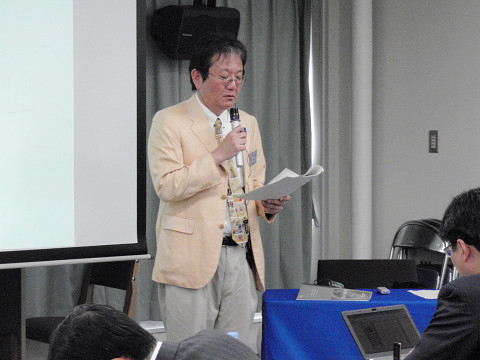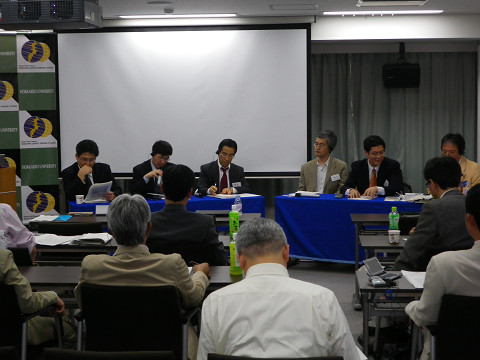
Full House at the 2010 Eastern Japan Conference of the Japan Association of Asian Studies
2010/05/24
The 2010 Eastern Japan Conference of the Japan Association for Asian Studies was held at Hokkaido University on May 22. The morning session consisted of 6 panels of presentations delivered by junior researchers as well as graduate students. Two GCOE members, Naomi Chi and Yohei Hirayama, presented their works, °»Foreign Policies under the Lee Myung-bak Administration°… and °»Implementation of Agricultural Taxes in North Vietnam during the 1st Indo-China War,°… respectively.
The afternoon session consisted of 2 panels, one that was co-hosted by the GCOE program entitled, °»China and its Frontiers: China°«s Maritime and Land Border Issues.°… Four panellists, Prof. Kawashima, Prof. Li, Prof. Sato and Prof. Yoshida delivered their presentations on, °»Memories of the Borders in Modern and Contemporary China,°… °»Maritime Border Disputes between China and Neighbouring Countries,°… °»China and its Frontiers: Border Issues in South China Sea,°… and °»Border Disputes between China and India,°… respectively.
Prof. Kawashima examined the historical memories and the dynamics of Chinese borders, while Prof. Li examined China°«s maritime border issues, factors that are prolonging the disputes and necessary elements to resolve these issues. Prof. Sato considered the disputes in the South China Sea and examined the issue of the map of South China Sea created by China, while lastly Prof. Yoshida focused on the land border disputes between China and India and examined the issues from the perspective of Indian nationalism and foreign relations.
One of the two discussants, Prof. Xing, commented on China-Russian border disputes and the bilateral efforts for resolution, while Director Iwashita referred to M.T. Fravel°«s book, °»Strong Border, Secure Nation,°… which states that the possibility of China resorting to violent conflict over territories are overstated. While developing the concepts of cooperation and escalation in territorial disputes, Fravel explains that when China is faced with internal threats it has been more willing to cooperate to strengthen its control over a certain territory, whereas China has been more prone to use force to avoid or reverse decline in its bargaining power in territorial disputes with powerful neighbouring countries. Fravel concludes that over the past sixty years China has been more likely to compromise than many experts might expect.
During the discussion, comments and questions concerning the possibility of China using military force, historical discourse in China, sports diplomacy, and the differences in resolving land and maritime territorial or border disputes (that is to say possibility of reaching common interests) were raised by the audience. Moreover, one participant also indicated that the importance of sea lane to China has less to do with China°«s attempt for escalation or to stress its bargaining power, but more to do with securing maritime resources in order to continuously support and promote its development, similar to any other countries, and that while China°«s basic diplomatic stance emphasizes flexibility and coordination, mutual understanding or understanding of the emotions concerning territorial disputes is crucial to reach a win-win situation.



The afternoon session consisted of 2 panels, one that was co-hosted by the GCOE program entitled, °»China and its Frontiers: China°«s Maritime and Land Border Issues.°… Four panellists, Prof. Kawashima, Prof. Li, Prof. Sato and Prof. Yoshida delivered their presentations on, °»Memories of the Borders in Modern and Contemporary China,°… °»Maritime Border Disputes between China and Neighbouring Countries,°… °»China and its Frontiers: Border Issues in South China Sea,°… and °»Border Disputes between China and India,°… respectively.
Prof. Kawashima examined the historical memories and the dynamics of Chinese borders, while Prof. Li examined China°«s maritime border issues, factors that are prolonging the disputes and necessary elements to resolve these issues. Prof. Sato considered the disputes in the South China Sea and examined the issue of the map of South China Sea created by China, while lastly Prof. Yoshida focused on the land border disputes between China and India and examined the issues from the perspective of Indian nationalism and foreign relations.
One of the two discussants, Prof. Xing, commented on China-Russian border disputes and the bilateral efforts for resolution, while Director Iwashita referred to M.T. Fravel°«s book, °»Strong Border, Secure Nation,°… which states that the possibility of China resorting to violent conflict over territories are overstated. While developing the concepts of cooperation and escalation in territorial disputes, Fravel explains that when China is faced with internal threats it has been more willing to cooperate to strengthen its control over a certain territory, whereas China has been more prone to use force to avoid or reverse decline in its bargaining power in territorial disputes with powerful neighbouring countries. Fravel concludes that over the past sixty years China has been more likely to compromise than many experts might expect.
During the discussion, comments and questions concerning the possibility of China using military force, historical discourse in China, sports diplomacy, and the differences in resolving land and maritime territorial or border disputes (that is to say possibility of reaching common interests) were raised by the audience. Moreover, one participant also indicated that the importance of sea lane to China has less to do with China°«s attempt for escalation or to stress its bargaining power, but more to do with securing maritime resources in order to continuously support and promote its development, similar to any other countries, and that while China°«s basic diplomatic stance emphasizes flexibility and coordination, mutual understanding or understanding of the emotions concerning territorial disputes is crucial to reach a win-win situation.









